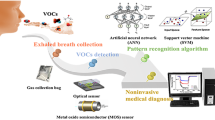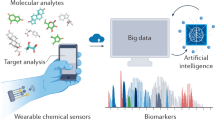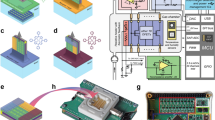Abstract
Rapid developments in sensor technology have facilitated the production of devices — known as electronic noses — that can detect and discriminate the production profiles of volatile compounds from microbial infections in situ. Such qualitative and semi-quantitative approaches could have a significant role in the early diagnosis and detection of microbial diseases. Using artificial intelligence and web-based knowledge systems, electronic noses might also have a valuable role in monitoring disease epidemiology.
This is a preview of subscription content, access via your institution
Access options
Subscribe to this journal
Receive 12 print issues and online access
$209.00 per year
only $17.42 per issue
Buy this article
- Purchase on Springer Link
- Instant access to full article PDF
Prices may be subject to local taxes which are calculated during checkout


Similar content being viewed by others
References
Persaud, K. & Dodd, G. Analysis of discrimination mechanisms in the mammalian olfactory system using a model nose. Nature 299, 352–355 (1982).
Pavlou, A., Turner, A. P. F. & Barr, H. Diagnosis of gastric and lung disorders. UK Patent 01155844.3 (1999).
Gibson, T. D., Puttick, P., Hulbert, J. N., Marshall, R. W. & Li, Z. Odor sensor. US Patent 5,928,609 (1999).
Lewis, N. & Freund, M. Sensor arrays for detecting microorganisms. US Patent 6,017,440 (2000).
Rong, L., Ping, W. & Yi, T. Flexible electronic nose for diabetes non-destructive breathing smell diagnosis. Canadian Patent CA2430111U (2001).
Armstrong, W. W., Coleman, R. N., Feddes, J. R., Guo, Q. G. & Leonard, J. J. Method and apparatus for estimating odor concentrations using an electronic nose. Canadian Patent CA2314237 (2002).
Hanson, C. W. Method and system of diagnosing intrapulmonary infection using an electronic nose. US patent US20033078611 (2003).
Gardner, J. W. & Bartlett, P. N. Electronic Noses: Principles and Applications (Oxford Univ. Press, UK, 1999).
Pearce, T. C., Schiffman, S. S., Nagle, H. T. & Gardner, J. W. (eds) Handbook of Machine Olfaction: Electronic Nose Technology (Wiley, 2002).
Turner, A. P. F. Biosensors — sense and sensitivity. Science 290, 1315–1317 (2000).
Piletsky, S. A. & Turner, A. P. F. in Optical Biosensors: Present and Future (eds Ligler, F. S. & Rowe Taitt, C. A.) 397–425 (Elsevier Science, UK, 2002).
Walt, R. D. et al. Optical sensor arrays for odour recognition. Biosensors and Bioelectronics 13, 697–699 (1998).
Suslick, K. S., Kosal, M. A., McNamara, W. B. & Sen, A. Smellseeing: a colorimetric electronic nose. Technical Digest, Proceedings of ISOEN'02, 27–28 (Rome, Italy, 2002).
Persaud, K. C., Pisanelli, A. M. & Evans, P. in Handbook of Machine Olfaction: Electronic Nose Technology (eds Pearce, T. C., Schiffman, S. S., Nagle, H. T. & Gardner, J. W.) 445–460 (Wiley, 2002).
Pavlou, A. et al. An in vitro rapid odour detection and recognition model in discrimination of H. pylori and other gastroeosophageal pathogens. Biosensors and Bioelectronics 15, 333–342 (2000).
Pavlou, A. et al. Use of an electronic nose system for diagnoses of urinary tract infections in vivo. Biosensors and Bioelectronics 17, 893–899 (2002).
Pavlou, A. et al. Detection of TB in vitro using electronic nose detection. Technical Digest, Proceedings of ISOEN'02, 238–239 (Rome, Italy, 2002).
Dutta, R., Hines, E. L., Gardner, J. W. & Boilot, P. Bacteria classification using Cyranose 320 electronic nose. BioMedical Engineering Online 1, 1–7 (2002).
Di Natale, C. et al. Electronic nose analysis of urine samples containing blood. Physiol. Measurement 20, 377–384 (1999).
Di Natale, C. et al. Lung cancer identification by analysis of breath by means of an array of non-selective gas sensors. Biosensors and Bioelectronics 18, 1209–1218 (2003).
Parry, A. D. & Oppenhaim, B. Leg ulcer odour detection identifies β-haemolytic streptococcal infection. J. Wound Care 4, 404–406 (1995).
Magan, N., Pavlou, A. & Chrysanthakis, I. Milke sense: a volatile sensory system for detection of microbial spoilage by bacteria and yeasts in milk. Sensors and Actuators B, 72, 28–34 (2001).
Keshri, G. & Magan, N. Detection and differentiation between mycotoxigenic and non-mycotoxigenic strains of Fusarium spp. using volatile production profiles and hydrolytic enzymes. J. Appl. Microbiol. 89, 825–833 (2000).
Needham, R. & Magan, N. Detection and differentiation of toxigenic and non-toxigenic Penicillium verrucosum strains on bakery products using an electronic nose. Aspects Appl. Biol. 68, 217–222 (2003).
Evans, P. et al. Evaluation of a radial basis function neural network for determination of wheat quality from electronic nose data. Sensors and Actuators B 69, 348–358 (2000).
Keshri, G., Magan, N. & Voysey, P. Use of an electronic nose for early detection and differentiation between spoilage fungi. Lett. Appl. Microbiol. 27, 261–264 (1998).
Pavlou, A. Novel intelligent gas-sensing in diagnosis of infectious diseases. PhD Thesis, Cranfield Univ. (2003).
Aathithan, S., Plant, J. C., Chaudry, A. N. & French, G. L. Diagnosis of bacteriuria by detection of volatile organic compounds in urine using an automated headspace analyser with multiple conducting polymer sensors. J. Clin. Microbiol. 39, 2590–2593 (2001).
Grametbauer, P., Kartusek, S. & Hausuer, O. Diagnosis of aerobic Gram negative bacteria by the detection of volatile metabolites using gas chromatography. Cesk Epidemiology Mikrobiology Immunology 37, 216–223 (1988).
Vitenberg, A. C., Stolbova, A. V., Loffe, B. V., Kocherovets, V. I. & Tsibul'skaia, I. A. Headspace gas chromatography analysis in the rapid diagnosis of anaerobic infections. Zh Mikribiology Epidemiology Immunobiology 1, 20–24 (1986).
Socolowsky, S, Hohne, C. & Sandow, D. The direct detection of volatile fatty acids by gas chromatography in microbiological diagnosis. Zeitschrift Med. Lab. Diagn. 31, 445–452 (1990).
Phillips, M. et al. Volatile markers of breast cancer in the breath. Breast J. 9, 184–191 (2003).
Phillips, M. et al. Detection of lung cancer with volatile markers in the breath. Chest 123, 1788–1792 (2003).
Olopade, C. O., Zakkar, M, Swedler, W. I. & Rubinstein, I. Exhaled pentane levels in acute asthma. Chest 111, 862–865 (1997).
Guernion, N., Ratcliffe, N. M., Spencer-Phillips, P. T. & Howe, R. A. Identifying bacteria in human urine: current practice and the potential for rapid, near-patient diagnosis by sensing volatile organic compounds. Clin. Chem. Lab. Med. 39, 893–906 (2001).
Kaji, H., Hisamura, M., Saito, N. & Murao, M. Gas chromatographic determination of volatile sulphur compounds in expired alveolar air in hepatopathic patients. J. Chromatogr. 145, 464–468 (1978).
Humad, S., Zarling, E., Clapper, M. & Skosey, J. L. Breath pentane excretion as a marker of disease activity in rheumatoid arthritis. Free Radicle Res. 5, 101–106 (1988).
Phillips, M., Sabas, M. & Greenberg, J. Increased pentane and carbon disulphide in the breath of patients with schizophrenia. J. Clin. Pathol. 46, 861–864 (1993).
Dobbelaar, P. et al. Detection of ketosis in dairy cows by analysis of exhaled breath. Veterinary Quality 18, 151–152 (1996).
Skrupskii, V. A. Gas chromatographic analysis of ethanol and acetone in the air exhaled by patients. Clin. Lab. Diagn. 4, 35–38 (1995).
Goldberg, E. M., Blendis, L. M. & Sandler, S. A gas chromatographic–mass spectrometric study of profiles of volatile metabolites in hepatic encephalopathy. J. Chromatogr. 226, 291–299 (1981).
Gibson, T. D., Prosser, O., Hulbert, J., Marshall, R. W. & Li, Z. Detection and simultaneous identification of microorganisms from headspace samples using and electronic nose. Sensors and Actuators B 44, 413–422 (1997).
Gardner, J. W., Craven, M., Dow, C. & Hines, E. L. The prediction of bacteria type and culture growth phase by an electronic nose with a multi-layer perceptron network. Measurement Sci. Technol. 9, 120–127 (1998).
Pavlou, A., Turner, A. P. F. & Magan, N. Recognition of anaerobic bacterial isolates in vitro using electronic nose technology. Lett. Appl. Microbiol. 35, 366–369 (2002).
Lykos, P., Patel, P. H., Morong, C. & Joseph, A. Rapid detection of bacteria from blood culture by an electronic nose. J. Microbiol. 39, 213–218 (2001).
Keshri, G., Vosey, P. & Magan, N. Early detection of spoilage moulds in bread using volatile production patterns and quantitative enzyme assays. J. Appl. Microbiol. 92, 165–172 (2002).
Needham, R. & Magan, N. Detection and differentiation of microbial spoilage organisms of bakery products in vitro and in situ. Proceedings of the Ninth International Symposium on Olfaction and Electronic Nose (eds D'Amico, A. & Di Natale, C.) 385–388 (Rome, Italy, 2003).
Keshri, G., Challen, M. P., Elliot, T. J. & Magan, N. Differentiation of Agaricus species and other homodasidiomycetes based on volatile production patterns using an electronic nose system. Mycol. Res. 107, 609–613 (2003).
Chandiok, S. et al. Screening for bacterial vaginosis: a novel application of artificial nose technology. J. Clin. Pathol. 50, 790–795 (1997).
Hanson, C. W. & Steinberger, H. A. The use of a novel 'electronic nose' to diagnose the presence of intrapulmonary infection. Anesthesiology 87, A269 (1997).
Ping, W., Yi, T., Haibao, X. & Farong, S. A novel method for diabetes diagnosis based on electronic nose. Biosensors and Bioelectronics 12, 1031–1036 (1997).
Author information
Authors and Affiliations
Corresponding author
Ethics declarations
Competing interests
The authors declare no competing financial interests.
Related links
Rights and permissions
About this article
Cite this article
Turner, A., Magan, N. Electronic noses and disease diagnostics. Nat Rev Microbiol 2, 161–166 (2004). https://doi.org/10.1038/nrmicro823
Issue Date:
DOI: https://doi.org/10.1038/nrmicro823
This article is cited by
-
Data-centric artificial olfactory system based on the eigengraph
Nature Communications (2024)
-
Biomimetic olfactory chips based on large-scale monolithically integrated nanotube sensor arrays
Nature Electronics (2024)
-
Demonstration of cross reaction in hybrid graphene oxide/tantalum dioxide guided mode resonance sensor for selective volatile organic compound
Scientific Reports (2023)
-
Chemiresistive sensing with functionalized carbon nanotubes
Nature Reviews Methods Primers (2023)
-
Smelling the Disease: Diagnostic Potential of Breath Analysis
Molecular Diagnosis & Therapy (2023)



